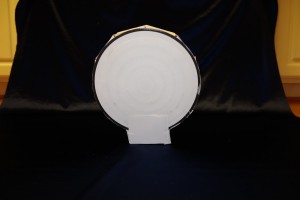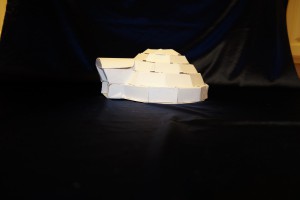In the game “Deal or No Deal” probability plays a large role in helping the contestant decide whether or not to take the money offered to them by the banker. The contestant can use the probability that they will win $1,000,000 to assist them in their decision. For us, our briefcase contained the $1,000,000 prize, so sticking with it until the end was the best option. I was quite confident that we had the winning prize because I chose the briefcase that made us win. Besides probability, I think the general ideals of a person effect how they play this game. For example, some people would rather have some money than none, and would rather not take that chance. Other people follow the “Go Big or Go Home” idea and always shoot for the $1,000,000. I like that idea. Since it costs nothing to go on the show, I say shoot for maximum prize, and if you don’t get it you still didn’t lose anything.
Tag: stewartp6
Flatland Pictures
3D Object Information
For the Flatland Project I chose to make an Igloo. Igloos are commonly made of ice in extreme places- namely the Artic, Antarctic, Scandinavia, northern Russia, or northern North America. The Word Igloo, or Iglu, simply means house. They were built as temporary houses by Eskimos and Traders to keep warm, while away from permanent structures during hunting season. They are designed to block out wind and retain heat, and because of this are best with a small tunnel connecting the house to the outdoors and no extra space (with extra space you have to heat more air). I chose to do an igloo because it is fairly simple, but has an interesting background and stereotype and, for its purpose, is slightly ingenious. I was also brainstorming for what to do as I trudged through the ice that coated my hill, which brought on ideas.
Encyclopedia Britannica, Editors. “Igloo | Dwelling.” Encyclopedia Britannica Online. Encyclopedia Britannica, n.d. Web. 01 Feb. 2016. <http://www.britannica.com/topic/igloo>.
Flatland Movie
Flatland the movie was an educational tale of a revolt from tyranny. It started with explaining the hierarchy of shapes within Flatland, and as they were showing that they showed most of the Flatland community. As the real story began to unfold, one of the main characters, Arthur Square, kept having strange dreams. In his most important dream, Arthur (and consequently the viewer) was shown the secret of the third dimension that the Circle tyrants were hiding. After he woke up and went to work, he found out that his curious grand-daughter, Hex, had ventured into the forbidden area 33h to find an answer to her idea of 3 dimensions. He rushes off to save her, but in the process is captured by the circles. During his public trial, he tells the secret to the entire community, and a revolution begins. Throughout the story I mainly learned about all of the dimensions, starting with a single point.
Time Capsule Project
Click here to access the e-book of my Time Capsule project.
Time Capsule Project: Retirement
My retirement fund starts lower than my income but grows at a faster rate. There are two reasons for this. The first is that my income grows at a rate of 2.5% annually while my interest rate on my retirement fund is 7.1% annually. The second reason is that the interest earned is a percentage of my invested money. When my income goes up, the amount of money I invest goes up as well. Since there is more money, the value of the percentage goes up as well, and therefore earning me more money. At the end of the 14th year investing, the value of my investments exceed my annual income. Nine years later, at the end of year 23, the value of my investments will be more than double my annual income.
Time Capsule Project: Budget
My budget shows a monthly representation of expenses making $32,256 annually working as a full-time intern at Geller architecture firm. My budgeted expenses are broken down by category. The largest category is income taxes which consumes 29% of my monthly expenditures. The second largest is car expenses which includes car payment, insurance, and gas. My living expenses include groceries, data services, personal care (hygiene), and clothing. My home expenses and savings are approximately the same, but home expenses are $27.43 more. Home expenses include my mortgage (which I share with William Coley), insurance, real estate taxes, and utilities. The other category includes donations, miscellaneous (extra savings for random occurrences), and entertainment. My total savings are comprised of an ordinary savings account and a retirement fund. My smallest category is total debt. My only debt is of student loans from graduate school, which I pay $202.49 monthly.
I did not have a lot of discretionary income, but the little I did have I chose to spend on data services, donations, and entertainment. I chose to get 15 Mbps (megabits per second) of internet bundled with television services for $50 a month, but since I have a roommate I only pay $25. Separately I have cell phone service for $32/month. Every month I donate $10 to Cary Academy for all of the wonderful experiences I had there. For entertainment I bought a Wii U with Mario Cart 8 and a small television all with my roommate.
Sticking to my budget will be fairly easy because I have enough money in each category to both deal with unexpected events or expenses and be lenient when it comes to wants. I should not have to worry about buying a new book every once in a while because my entertainment budget has extra money each month- a Wii U is a onetime fee. Even through this leniency my budget will have to change drastically about five years out of graduate school, when I move from an Intern to an Urban Design Planner. My salary will be more than three times my current, so I will, even with the increased taxes, have much more money to use to shape my life.
Time Capsule Career
Coming out of graduate school I will work for the Gensler architecture firm as an architect intern making about $16 per hour. My focus as an intern will be on urban design and planning. I hope to design master plans for mixed use development. After five years I will move to New York City and work for Skidmore, Owings, and Merrill LLP as a Senior Urban Designer. Senior Urban Designers create plans, documents, presentations, models, and scale visualizations of the buildings and sites. They check all of the coordinate calculations and scales. Finally they coordinate with building teams and the consultants such as the main Structural Engineer on the project.
The requirements to be a Senior Urban Designer at SOM are completion of a five-year architecture program, graduate of a two-year urban design program, at least five years of urban design/planning, and demonstrated knowledge of urban design, urban history and theory, environmental law, and private and public development. Not including cash or stock bonuses I will start out making about $100,000 a year.
A Snip of My CultureVerse
When I was four years old I started to sketch and explore art. I found that it was a fun, interesting way to express feelings and convey messages. I mostly did little drawings, but by the time I was five years old I was trying to make bigger, grander pieces. I figured out that it is much easier to draw nicer pieces if there was not anything to model my artwork after. For example: it was much easier to draw a random, improvisational pattern or mismatch non-humanoid face then a person or an animal. Because of this I looked into abstract art and Wassily Kandinsky. I admired his work enough that in second grade I traveled with my mother to Washington D.C. and the National Gallery of Art to see his work. That inspired me and I started to take art classes and camps along with looking into other genres. I found interest in surrealism, impressionism, post-impressionism, and many modern sculptures.





